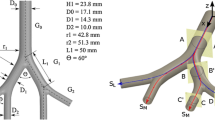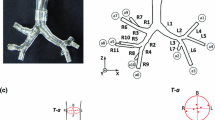Abstract
The steady inspiratory flow through an anatomically accurate model of the human airways was studied experimentally at a regime relevant to deep inspiration for aerosol drug delivery. Magnetic resonance velocimetry was used to obtain the three-component, mean velocity field. A strong, single-sided streamwise swirl was found in the trachea and persists up to the first bifurcation. There, the swirl and the asymmetric anatomy impact both the streamwise momentum distribution and the secondary flows in the main bronchi, with large differences compared to what is found in idealized branching tubes. In further generations, the streamwise velocity never recovers a symmetric profile and the relative intensity of the secondary flows remains strong. Overall, the results suggest that, in real human airways, both streamwise dispersion (due to streamwise gradients) and lateral dispersion (due to secondary flows) are very effective transport mechanisms. Neglecting the extrathoracic airways and idealizing the bronchial tree may lead to qualitatively different conclusions.











Similar content being viewed by others
References
Ball C, Uddin M, Pollard A (2008) High resolution turbulence modeling of airflow in an idealized human extrathoracic airway. Comput Fluids 37:943–964
Briant J, Cohen B (1989) Flow distribution through human and canine airways during inhalation and exhalation. J Appl Phys 67:1649–1654
Brouns M, Verbanck S, Lacor C (2007) Influence of glottic aperture on the tracheal flow. J Biomech 40:165–172
Chang H, Menon A (1985) Airflow dynamics in the human airways. In: Aerosol in medicine: principles, diagnosis and therapy. Elsevier, Amsterdam, pp 75–112
Choi J, Tawhai M, Hoffman E, Lin C (2009) On intra-and intersubject variabilities of airflow in the human lungs. Phys Fluids 21(101):901
Cohen B, Sussman R, Lippmann M (1993) Factors affecting distribution of airflow in a human tracheobronchial cast. Respir Physiol 93:261–278
Comer J, Kleinstreuer C, Zhang Z (2001) Flow structures and particle deposition patterns in double-bifurcation airway models. Part 1: air flow fields. J Fluid Mech 435:25–54
de Rochefort L, Vial L, Fodil R, Maitre X, Louis B et al (2007) In vitro validation of computational fluid dynamic simulation in human proximal airways with hyperpolarized \(^{3}\text{He}\) magnetic resonance phase-contrast velocimetry. J Appl Phys 102:2012–2023
Elkins C, Alley M (2007) Magnetic resonance velocimetry: applications of magnetic resonance imaging in the measurement of fluid motion. Exp Fluids 43:823–858
Fresconi F, Prasad A (2007) Secondary velocity fields in the conducting airways of the human lung. J Biomech Eng Trans ASME 129:722–732
Golshahi L, Finlay W (2009) Recent advances in understanding gas and aerosol transport in the lungs: application to predictions of regional deposition. Adv Transp Phenom 1:1–30
Grosse S, Schroder W, Klaas M, Klockner A, Roggenkamp J (2007) Time resolved analysis of steady and oscillating flow in the upper human airways. Exp Fluids 42:955–970
Grotberg J (1994) Pulmonary flow and transport phenomena. Annu Rev Fluid Mech 26:529–571
Heenan A, Matida E, Pollard A, Finlay W (2003) Experimental measurements and computational modeling of the flow field in an idealized human oropharynx. Exp Fluids 35:70–84
Hindle M, Byron P (1995) Dose emissions from marketed dry powder inhalers. Int J Pharm 116:169–177
Horsfield K, Dart G, Olso D, Filley G, Cumming G (1971) Models of the human bronchial tree. J Appl Physiol 31:207–217
Hughes J, Hoppin F Jr, Mead J (1972) Effect of lung inflation on bronchial length and diameter in excised lungs. J Appl Phys 32:25–35
Isabey D (1982) Steady and pulsatile flow distribution in a multiple branching network with physiological applications. J Biomech 15:395–404
Jeong J, Hussain F (1995) On the identification of a vortex. J Fluid Mech 285:69–94
Johnstone A, Uddin M, Pollard A, Heenan A, Finlay W (2004) The flow inside an idealized form of the human extrathoracic airway. Exp Fluids 37:673–689
Kabilan S, Lin C, Hoffman E (2007) Characteristics of airflow in a CT-based ovine lung: a numerical study. J Appl Phys 102:1469–1482
Kleinsteuer C, Zhang Z (2010) Airflow and particle transport in the human respiratory system. Annu Rev Fluid Mech 42:301–334
Li Z, Kleinstreuer C, Zhang Z (2007b) Simulation of airflow fields and microparticle deposition in realistic human lung airway models. Part \(1\): airflow patterns. Eur J Mech B Fluids 26:632–649
Lin C, Tawhai M, McLennan G, Hoffman E (2007) Characteristics of the turbulent laryngeal jet and its effect on airflow in the human intrathoracic airways. Respir Physiol Neurobiol 157:295–309
Longest P, Holbrook L (2012) In silico models of aerosol delivery to the respiratory tract—development and applications. Adv Drug Deliv Rev 64:296–311
Longest P, Xi J (2007) Computational investigation of particle inertia effects on submicron aerosol deposition in the respiratory tract. J Aerosol Sci 38:111–130
Nithiarasu P, Hassan O, Morgan K, Weatherill N, Fielder C et al (2008) Steady flow through a realistic human upper airway geometry. Int J Numer Methods Fluids 57:631–651
Padilla A (2012) The effect of upstream perturbations on 3D annular diffusers. PhD thesis, Stanford University
Pedley T (1977) Pulmonary fluid dynamics. Annu Rev Fluid Mech 9:229–274
Pelc N, Sommer F, Li K, Brosnan T, Herfkens R et al (1994) Quantitative magnetic resonance flow imaging. Magn Reson Q 10:125–147
Shinneeb A, Pollard A (2012) Investigation of the flow physics in the human pharynx/larynx region. Exp Fluids 53:989–1003
Soodt T, Pott D, Klaas M, Schroeder W (2013) Analysis of basic flow regimes in a human airway model by stereo-scanning PIV. Exp Fluids 54:1–10
Stapleton K, Guentsch E, Hoskinson M, Finlay W (2000) On the suitability of \(k\)–\(\epsilon\) modelling for aerosol deposition in the mouth and throat: a comparison with experiment. J Aerosol Sci 31:739–749
Tang C, Blatter D, Parker D (1993) Accuracy of phase-contrast flow measurements in the presence of partial-volume effects. JMRI 3:377–385
Theunissen R, Riethmuller M (2008) Particle image velocimetry in lung bifurcation models. In: Schroeder A, Willert C (eds) Particle image velocimetry: new developments and recent applications. Springer, Berlin, pp 73–101
Thornton S, Marion J (2004) Classical dynamics of particles and systems. Brooks/Cole, Belmont, California
Wall W, Rabczuk T (2008) Fluid–structure interaction in lower airways of CT-based lung geometries. Int J Numer Methods Fluids 57:653–675
Weibel E (1963) Morphometry of the human lung. Academic Press, New York
Yin Y, Choi J, Hoffman E, Tawhai M, Lin C (2013) A multiscale MDCT image-based breathing lung model with time-varying regional ventilation. J Comput Phys 244:168–192
Zhang Z, Kleinstreuer C (2002) Transient airflow structures and particle transport in a sequentially branching lung airway model. Phys Fluids 14:862–880
Zhang Z, Kleinstreuer C (2004) Airflow structures and nano-particle deposition in a human upper airway. J Comput Phys 198:178–210
Zhang Z, Kleinstreuer C, Hyun S (2012) Size-change and deposition of conventional and composite cigarette smoke particles during inhalation in a subject-specific airway model. J Aerosol Sci 46:34–52
Acknowledgments
This research was supported in part by the US Army Research Laboratory, through the Army High Performance Computing Research Center, Cooperative Agreement W911NF-07-0027. Clement Kleinstreuer (North Carolina State University) kindly provided the segmented model of the subject-specific airways. We are thankful to Gianluca Iaccarino (Stanford, Mechanical Engineering), Eric Shaqfeh and Jorge Bernate (Stanford, Chemical Engineering), Carlos Milla and Peter Kao (Stanford, Pulmonary Medicine), Kevin Stapleton (Allergan Corp, Mountain View, CA), and Clement Kleinstreuer for their valuable insight during several fruitful discussions.
Author information
Authors and Affiliations
Corresponding author
Rights and permissions
About this article
Cite this article
Banko, A.J., Coletti, F., Schiavazzi, D. et al. Three-dimensional inspiratory flow in the upper and central human airways. Exp Fluids 56, 117 (2015). https://doi.org/10.1007/s00348-015-1966-y
Received:
Revised:
Accepted:
Published:
DOI: https://doi.org/10.1007/s00348-015-1966-y




